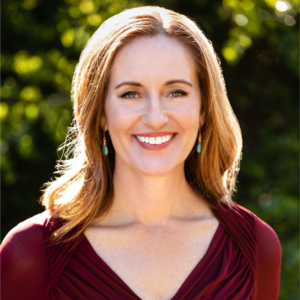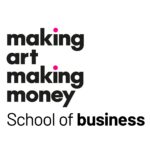If you don't know your niche you will struggle to sell your art, and you won't know why.
What happens if an artist doesn't know their niche?
Hello, my name is Ann Rea
and I’m an artist just like you
and I’m a mentor to about 23 different types of established
and emerging artists in 20 countries and counting now
and one of the questions I get all of the time is ‘how can I find more collectors?’
who doesn’t want to know the answer to that right?
Well, there is actually a way to figure out how to find more collectors.
And so that means that you know your niche.
or niche, also known as the target market, also known as your tribe.
So what I’d love for you to do right now is I’d love for you to draw three circles
that overlap in the middle
and I’m going to actually share with you the formula that I teach my students
and it’s called the four-part code.
Now every single artist living or dead
had a four-part code
and the good news about this is this is something you can actually learn
and in my experience it’s much easier to learn this than it is to learn how to make art.
Now how did I come across this?
So a little bit of back story when I was in art school,
one of the things that was really important to me was understanding why was one artist famous
and landed in the art history books
and why was another not and I would beg my art professors
for the answer but they didn’t have it. Art historians did not have the answer.
Art critics did not have the answer. I would even walk across to the museum
and ask the docents and no one seemed to have the answer.
It wasn’t until much later when I became a student of the luxury market,
that I finally understood why one artist was successful and another not
and it’s a really simple thing.
It’s because at some point in time there was a market for their work
some group of people a niche, niche, tribe, target market, wanted to buy that art.
That’s the only reason.
So artists will eagerly asked me. “How do I find my niche?” “How do I find my niche?”
Well, here’s the process.
Here’s the formula. It’s really simple.
So in that first circle of three that I just had you draw that overlap in the middle.
I would like you to label one of those circles ‘My WHY’ and then I’d like you to label another circle ‘My WHAT’
and another circle ‘My HOW’ and in that small intersecting space in the middle.
I’d like you to label that space ‘My WHO’
So let’s start with ‘My WHY’
now, what I’m going to do is break down the process
everything that is created has a process whether it is baking a cake
whether it is creating a painting
or designing jewelry everything that’s created has a process
and so I’m going to teach you the process right now
and how artists actually define and find their niche, okay.
I’m going to say niche because I’m American,
but I know I have students from all over the world,
so you can express it or pronounce it any way you like.
So first of all, what is ‘My WHY’ well your WHY is unique to you
it has everything to do with you
it is who you are it is what you stand for and it is what you stand against
it’s your souls truth and it’s got nothing to do with your art.
It has everything to do with you.
Once you know your why which frankly most people never learn in their lifetime, but my students do
once you know your why
then you know your WHAT
which is what problem in the world you believe is worth solving
and this is a problem that’s greater than you
and that’s got nothing to do with you
and it’s got nothing to do with your art these two pieces the the ‘why’ and the ‘what’
that’s actually, that unfolds inside of the Making Art Making Money program,
but then we come to the ‘how’
so that’s how you create clear value above and beyond your art itself.
So using another skill or another resource you add value
because here’s the alternative if you just create create Arts For Art’s Sake,
First of all, you’re not going to get very far
because there’s too much talent out there and even if you’re enormously talented,
it’s very difficult to get noticed
or differentiated without that ‘how’ without additional value above and beyond the art itself.
So that’s again just another resource or another skill that you combine with your offer.
Now that’s actually something that my students test during their final project.
We call it the Prototype project
and the Prototype project is a final project where you test your knowledge
and you either sell your art or you don’t sell your art.
Here’s the good news. Either way is actually okay
because you want to know why you sold your art and you want to know why you didn’t sell your art.
And once you’ve sold enough of your art,
then you realize who wants to buy your art.
That’s that space in the middle. That’s the target market.
Who aligns with your mission, number one, and who can afford art because let’s face it art’s a luxury.
You can have a philosophical debate about that all day long,
but the fact is the dictionary definition of art is it is indeed a luxury.
So that’s the four-part code.
If you’d like to learn a little bit more about that than I invite you to apply to enroll in the program.
We’re currently looking for five artists who want to
double their level of focus within the next 30 days
while they’re learning how to sell their art.
Hopefully this demystifies why one artist is successful
and another artist is not
and it presents you with a roadmap, with a process, where you too can learn your niche
who wants to buy your art and why they want to buy it.
Now one final note on what does it mean to know your niche?
This isn’t something you can guess at. Guessing is really hazardous
and it wastes a ton of time, it wastes a ton of money
and you’ll lose opportunities because you don’t know your niche.
So what is knowing your niche mean?
Well number one, it means you know who wants to buy your art.
Number two, you know why they want to buy your art
and number three, you know where to go find more people just like them
and you know how to cultivate those relationships and celebrate your tribe.
Once you know your niche and you serve your niche then that’s it.
That’s the keys to the kingdom
and like anything like learning how to make art, learning how to sell and market your art,
it’s a process but the good news is it’s a process that you can learn
just like you learned how to make art.

Ann Rea, Fine Artist & Mentor
Ann Rea is a San Francisco-based fine artist. She created Making Art Making Money™, the leading and most reputable business program for fine artists since 2005. Rea’s art and business savvy have been featured on ABC, HGTV, Creative Live, The Good Life Project, in the book Career Renegade by Jonathan Fields, the San Francisco Chronicle, Art Business News, Fortune, and Inc. Magazines. Rea’s artistic talent was commended by her mentor, art icon Wayne Thiebaud.
